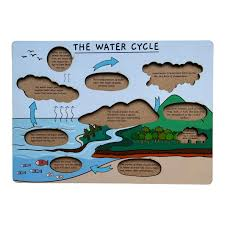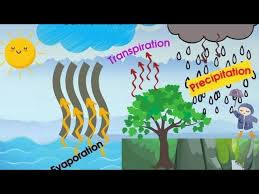Now Reading: Discover the Water Cycle: Nature’s Magic Recycling System 2025
-
01
Discover the Water Cycle: Nature’s Magic Recycling System 2025
Discover the Water Cycle: Nature’s Magic Recycling System 2025

Table of Contents
Water is one of the most important elements for life on Earth. We drink it, cook with it, clean with it, and even play in it. But have you ever wondered how water moves around our planet? The answer lies in a natural system called the water cycle.
The water cycle is a continuous journey of water that keeps moving through different stages. This system has been working for billions of years, and it helps keep our environment balanced. Let’s explore how the water cycle works in simple and clear steps.
What is the Water Cycle?

The water cycle (also known as the hydrological cycle) is the process by which water travels between the earth, the atmosphere, and back again. It involves several key stages: evaporation, condensation, precipitation, collection, and infiltration. These steps help water move from oceans, rivers, and lakes to the sky and back again.
The water cycle is a closed system. This means the Earth doesn’t get more water or lose it—it’s simply being reused again and again.
Step 1: Evaporation – Water Rises
The cycle begins with evaporation. When the sun shines on oceans, rivers, lakes, or even puddles, the heat causes the water to change into vapor. This invisible gas then rises into the sky. The warmer the temperature, the faster the water evaporates.
Plants also help in this stage. Through a process called transpiration, plants release water vapor from their leaves. Together, evaporation and transpiration are known as evapotranspiration.
Example: Think of a wet towel left outside on a sunny day. After a few hours, it becomes dry. That’s evaporation at work.
Step 2: Condensation – Clouds Form
As water vapor rises higher, it starts to cool down. When it cools, it turns back into tiny water droplets. This change is called condensation.
These droplets gather together to form clouds. If you’ve seen fog on a cold morning, that’s also condensation happening near the ground. The cooler the air, the more likely it is for condensation to occur.
Example: Imagine you breathe on a cold window and see foggy mist appear. That’s a simple form of condensation.
Step 3: Precipitation – Water Falls Back
When clouds become too heavy with water droplets, the droplets fall back to Earth. This is called precipitation.
Precipitation comes in different forms—rain, snow, sleet, or hail—depending on the temperature. This is how water returns from the sky to the surface of the Earth.
Example: When dark clouds gather and it starts raining, that’s precipitation. Snow during winter and hailstorms are also types of precipitation.
Step 4: Collection – Water Gathers Again
After precipitation, water collects in different places. This stage is called collection.
Some of the water will run off hills and roads into streams, rivers, and eventually into oceans or lakes. This movement is called runoff. Other water will soak into the soil and help plants grow or become underground water.
This collected water will eventually evaporate again, and the cycle continues.
Example: After a rainstorm, you’ll see puddles on the ground, rivers flowing stronger, or lakes rising. That’s all part of water being collected again.
Step 5: Infiltration – Water Soaks In
Not all rainwater becomes runoff. Some of it goes deep into the soil. This step is called infiltration. Water that soaks into the ground can become part of the groundwater system.
This underground water helps support plant roots, feeds springs, and may even end up in wells. Groundwater is also an important source of drinking water in many parts of the world.
Example: Have you noticed the soil feels damp even if there’s no puddle? That’s because the water has infiltrated the ground.
Why is the Water Cycle Important?
The water cycle helps clean and recycle water. It moves water through the air, land, and oceans. Without this natural system, life would not be possible.
Here’s why it matters:
- Supports Life: All living things need water to survive. The water cycle ensures fresh water is always available.
- Regulates Climate: It helps control Earth’s temperature and weather patterns.
- Purifies Water: As water evaporates, it leaves behind dirt and salt, making it clean again.
- Fills Rivers and Lakes: Keeps water bodies full and ecosystems healthy.
Human Impact on the Water Cycle

While the water cycle is natural, human activities are affecting it. Pollution, deforestation, and climate change can all change how the cycle works.
For example:
- Air pollution can make rain more acidic, which can harm plants and animals.
- Cutting trees reduces transpiration and may change rainfall patterns.
- Global warming increases evaporation, leading to stronger storms or droughts in some places.
To protect the water cycle, we must take care of our planet by saving water, planting trees, and reducing pollution
Fun Facts About the Water Cycle
- The same water you’re drinking today may have been drunk by a dinosaur millions of years ago.
- About 97% of the Earth’s water is salty. Only 3% is fresh, and most of that is frozen.
- Clouds may look light, but a single cloud can hold millions of liters of water.
- Water can stay in one stage of the cycle for years. For example, water in glaciers can stay frozen for thousands of years.
Conclusion
The water cycle is an amazing natural system that moves water around our planet. It works quietly in the background but is always active. From evaporation to precipitation and collection, each step plays a vital role in keeping life on Earth going.
Next time it rains or you see fog or a puddle drying up, remember—it’s all part of the incredible journey of water.
Understanding how the water cycle works helps us appreciate water more and reminds us to protect this valuable resource. Nature has its way of recycling, and the water cycle is one of its greatest examples.
Read More:- Shobha Realty Launches Its Most Luxurious Project Yet—Full Details Inside 2025






















